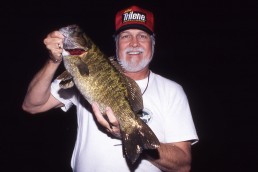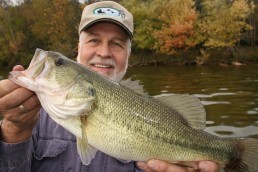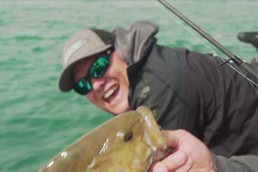Night Fishing for Black Bass
SHARE THIS POST
It’s quiet at night. There’re fewer boats and no skiers. You may not have a lake to yourself, but have better fish-catching opportunities. The following are a few excellent bass lakes in Middle Tennessee to ply your skills (or luck, if you aren’t so skillful), but keep in mind it’s better to start fishing before dark so you’re set and ready for the night of angling.
Old Hickory Lake
Guide, Jim Duckworth, who walked the length of Old Hickory underwater during his mussel diving days, says, “You can catch 50 bass from one long section of milfoil. Bass will hit several baits. Plastic rats or frogs can be worked over the weeds without your hooks being fouled with green vegetation.”
Milfoil is an aquatic plant that provides bass with many of its needs, once they have spawned. In summer, the weed patches are sanctuaries for small fish – bass food.
“Rigging a big plastic worm weedless-style, without the slip sinker, works just as well. The bass have to pinpoint your bait through the weeds. They miss often enough, but mostly because anglers get too excited and pull the bait away before the bass can get a bite of it.”
Jim says, “You should think about Old Hickory Lake as if it were three different lakes. On the lower end, you have a very large lake. Wide, with mostly subtle bottom changes except for the deep channel, long tapering points and big grass flats just right for casting weedless frogs. The long, 15-foot-deep creeks with flats are what bass love for chasing shad. The lower end has lots of good places to flip a jig: docks, laydowns and boats. Drakes Creek, he adds, has always been the best creek on the lower end.
“The middle of the lake has some of the same structure and cover, but it also has a lot of very sharp drops where the larger bass like to hold. The Rat-L-Trap is king for catching numbers of bass but the bigger fish will hit crankbaits on the drops. My baits of choice are Bandits and two-ounce spinnerbaits. Both of these baits cover water quickly to find those schooling fish.”
His baits of choice for fishing this upper river section are grub-n-jig and crankbaits. He says, “There are many bluffs and deep drops with plenty of shad. Depending on the water temperature, you may be better off on the lower half of the lake. The upper end of the reservoir never gets above 75 degrees, even in the middle of the summer.
Normandy Lake
Tom Waynick, who lives on Normandy Lake, says, “Structure-oriented bass usually follow a pattern with a particular structure at the center of their world. There are few structures that attract bass in the late summer more than deepwater humps.”
It’s important to locate humps in relation to deep water. A topographic map will make this easy for you, if there is no one to show you these honey holes.
“Humps vary in size, shape and depth,” says Tom. “The heaviest largemouths seem to prefer the largest humps with tops less than 10 feet from the surface. Sometimes the most productive humps are the ones on an otherwise featureless flat next to a river or creek channel. You can make a hump more appealing by putting brush piles and logs on it. Brush attracts baitfish. Bass seem to prefer logs.”
Are you enjoying this post?
You can be among the first to get the latest info on where to go, what to use and how to use it!
He adds that the Carolina rig works best for him on the humps. “I Texas rig a pumpkinseed, watermelon or green pumpkinseed lizard on a 5/0 hook. I dip the tail in chartreuse Spike-It. I don’t know why, but that extra color on the lizard makes it more effective. Or, maybe it gives me more confidence.”
Tom makes his cast to the top of the hump when his boat in about 25 to 30 feet of water. “When the weight hits bottom, I begin a slow, steady crank. If it stops, I continue to crank slowly. If it is hung, in about three or four cranks, it will pop loose. If it doesn’t come loose, I set the hook. Most times I don’t feel the fish, the line gets heavy. It’s like reeling in a wet towel. I keep cranking until the tip loads up, then I promptly sweep the rod to the side.”
His favorite places on Normandy are the main channel flats and humps near the Hiles Road Bridge, and the mouths of Riley Creek and Carroll Creek.
Tims Ford Lake
D.D. Fuller of Tullahoma tells us “to get started night fishing on Tims Ford by using your sonar to locate deep channel drops. The drops I’m talking about are on the edge of the channel, either the main channel or feeder creeks. Smallmouths relate to current more than largemouths do and there is generally more current along the drops.
“For largemouth bass, I focus on the humps.” There are humps near the dam at the place called “The Narrows” (where the channel makes a big loop) and the area around Leatherwood Island. There are also humps at Fanning Bend, Maple Bend and in Lost, Hurricane and Little Hurricane Creeks.
“I use reflective marker buoys to mark the drops,” says D.D. “I cruise the edge of a channel drop or hump and toss out buoys on the top edge of the breakline. I go down the break marking the top of the breakline, like I was marking the side of a football field. Before I mark the breakline, I look at my sonar to see if the drop has the proper structure that holds fish.”
D.D. looks for rocks, pebbles or gravel, a hard bottom of some type. Smallies relate to this bottom whereas largemouths relate more to vegetation. He says he finds both fish on wood.
Bottom line
There you have three lakes where you can ply the waters at night. Now, be careful out there—it’s dark.
For more information…
…on Old Hickory Lake, contact guide Jim Duckworth fishingtennessee.com, 615-444-2283
MWO
SHARE THIS POST
You may also like...
0 CommentsNight Fishing for Largemouth Bass on Cedar Lake
Did you enjoy this post?
You can be among the first to get the latest info on where to go, what to use and how to use it!
Vernon Summerlin
For more than 30 years, Vernon Summerlin has produced outdoor articles and books that can be found on Amazon; most recently How to Analyze a Bass Hole: Think and Catch’em! He is the recipient of more than 40 awards for magazine and newspaper articles, TV, radio, photography and books.





